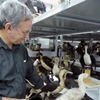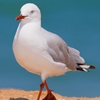General Description
Upper body mottled light grey, underparts white. White marking across base of tail. Curved white stripe above the eye. Bill narrow and black. When breeding: upperparts red-brown and black, underparts white with black spots at the side and on the breast. Body up to 28 cm long.
Biology
Great Knots migrate from the northern hemisphere where they breed, to Victoria in summer. They arrive in late October and depart in February.
Habitat
Intertidal mudflats.
Coastal shores
Distribution guide
Worldwide.
Species Group
Birds › Sandpipers and curlews
Max Size
28 cm
Diet
Carnivore
Commercial Species
Yes
Global Dispersal
Recorded in Australia
Conservation Status
- DSE Advisory List : Endangered
- EPBC Act 1999 : Not listed
- IUCN Red List : Vulnerable





